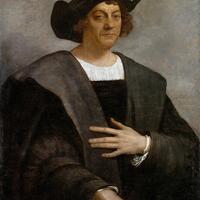More about Brooklyn Museum

Contributor
The Brooklyn Museum, home of both feminist art and a huge glass ceiling.
It might not be as well known as MoMA or the Met, but the Brooklyn Museum is the third largest museum in NYC. In physical size it stands at 560,000 square feet and houses roughly 1.5 million works of art. The museum is housed in a dark and kitschy beaux-arts building, but in 2004 they opened the 15,000-square-foot Martha A. and Robert S. Rubin Pavilion, entirely made out of glass.
After marrying his American lover Martha Cock, young Brit Richard King was issued a certificate of naturalization in 1808. It was also around that time that Richard met his new bff John Bell. The two were quite a couple! They not only decided to jointly adopt a new last name, they also moved upstate, leaving wife and kids behind. They called it “a quest of better fortunes,” but we all know it was all about “leaving your wife and kids because you fell in love with your best friend.” The two lovers, now known as the “Graham brothers,” started a brewery and distillery in Norwich. In 1815, they moved their booze business to Brooklyn. Alcohol = money, because in 1822 the couple retired and divided their large fortune.
Augustus Graham founded the Apprentices’ Library, which offered lectures and entertainment for anyone, but young workingmen in particular. Even though he had been in the alcohol biz for years, Graham was part of the first temperance movement in Brooklyn. He banned all alcohol from the library, which some ladies found very “ungentlemanly.” The library grew into the Brooklyn Institute which became the Brooklyn Museum of Art.
Nowadays, the museum has a huge collection of, well... almost everything! Egyptian and African art, 17th century to contemporary artworks, paintings, sculptures and decorative arts from many different schools. Most notable though is the Elizabeth A. Sackler Center for Feminist Art which opened in 2007. In 2012, the Sackler family again made a huge donation “something with seven figures” to make sure the museum would always have a permanent curator of feminist art. Pretty awesome. The Center has been the permanent home of Judy Chicago’s epic work The Dinner Party ever since it opened.
No museum goes without at least one controversy though, the biggest controversy at the Brooklyn in 1999 had something to do with elephant dung. In short, Turner prize winner Chris Ofili painted the Holy Vrigin Mary surrounded by images from blaxploitation, vulvas, and elephant dung. Rudolph Giuliani (then Mayor of New York City) called it “sick stuff” and threatened to terminate the museum’s lease with the city and seize control. Some say it was all because the museum didn’t allow unsupervised minors to visit the exhibition, which presumably was a violation of the lease. But we all know it was just about a religious, white, cis-dude acting like a spoiled brat. 100 actors, writers, artists and (then FLOTUS) Hillary Clinton supported Ofili and the museum. Like Ofili said "elephant dung in itself is quite a beautiful object."
Featured Content
Here is what Wikipedia says about Brooklyn Museum
The Brooklyn Museum is an art museum in the New York City borough of Brooklyn. At 560,000 square feet (52,000 m2), the museum is New York City's second largest and contains an art collection with around 500,000 objects. Located near the Prospect Heights, Crown Heights, Flatbush, and Park Slope neighborhoods of Brooklyn, the museum's Beaux-Arts building was designed by McKim, Mead & White.
The Brooklyn Museum was founded in 1823 as the Brooklyn Apprentices' Library and merged with the Brooklyn Institute of Arts and Sciences in 1843. The museum was conceived as an institution focused on a broad public. The Brooklyn Museum's current building dates to 1897 and has been expanded several times since then. The museum initially struggled to maintain its building and collection, but it was revitalized in the late 20th century following major renovations.
Significant areas of the collection include antiquities, specifically their collection of Egyptian antiquities spanning over 3,000 years. European, African, Oceanic, and Japanese art make for notable antiquities collections as well. American art is heavily represented, starting at the Colonial period. Artists represented in the collection include Mark Rothko, Edward Hopper, Norman Rockwell, Judy Chicago, Winslow Homer, Edgar Degas, Georgia O'Keeffe, and Max Weber.
Check out the full Wikipedia article about Brooklyn Museum



















